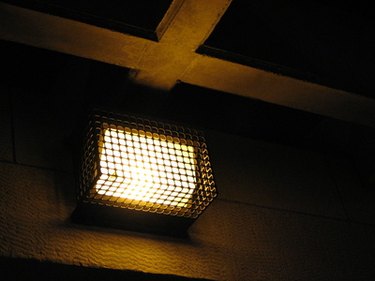
Whether it's for security, convenience or a way to be hospitable to unexpected visitors, a motion sensor wired to a light will brighten up the approach to your house when guests or intruders come in range. If there are two approaches to your home, or to the area you wish to illuminate, rig a pair of sensors to cover both approaches.
Choose Sensor
Video of the Day
Motion sensors work in several ways. Some work with lights and photo cells. Others detect the heat coming off a human body or send out ultrasonic signals becoming miniature radar systems. Each type has benefits and pitfalls so check out the types available then decide which type is best for the application you are planning. All sensors will work with incandescent lights but some sensors won't work with fluorescent light fixtures. Be sure to check for compatibility if you are planning to have them operate fluorescent lights.
Video of the Day
The Basics
A motion sensor to turn on a light is nothing more than a fancy light switch. Most have four components: the motion-sensing device (many have adjustable sensitivity to limit its range), a timer that starts when the motion sensor activates (many have adjustable timers to adjust the amount of time a light hooked to it will stay lit), a photocell that deactivates the switch during the daylight hours and an override function allowing the light to be turned on with a conventional switch or to deactivate the motion sensor to ensure the light won't be lit.
The Setup
The setup for most systems is straightforward. Mount the sensors to cover the areas you wish to be able to detect motion and activate. Power for the system can come from the electrical panel or from tapping into an existing electrical circuit. From the power source, the electricity routes through a conventional light switch, used to manually override the motion switches, if need be. From the conventional switch, route a wire to each of the motion sensors and from each motion sensor a wire will need to be run to the light fixture. Consult an electrician or the installation diagrams that come with the sensors to ensure they get hooked up correctly.
Adjustment
Either wait until dark or cover the photocell receptor to make the sensor think it's dark, then test and make adjustments to the aim and sensitivity of the sensors to ensure they are working as you desire. The timer in each sensor is independent of the other so if both sensors are activated, the timer on whichever sensor was activated last will be the one that controls how long the light will stay lit.